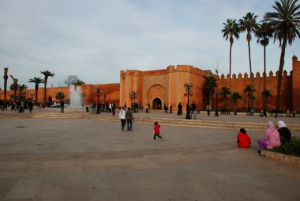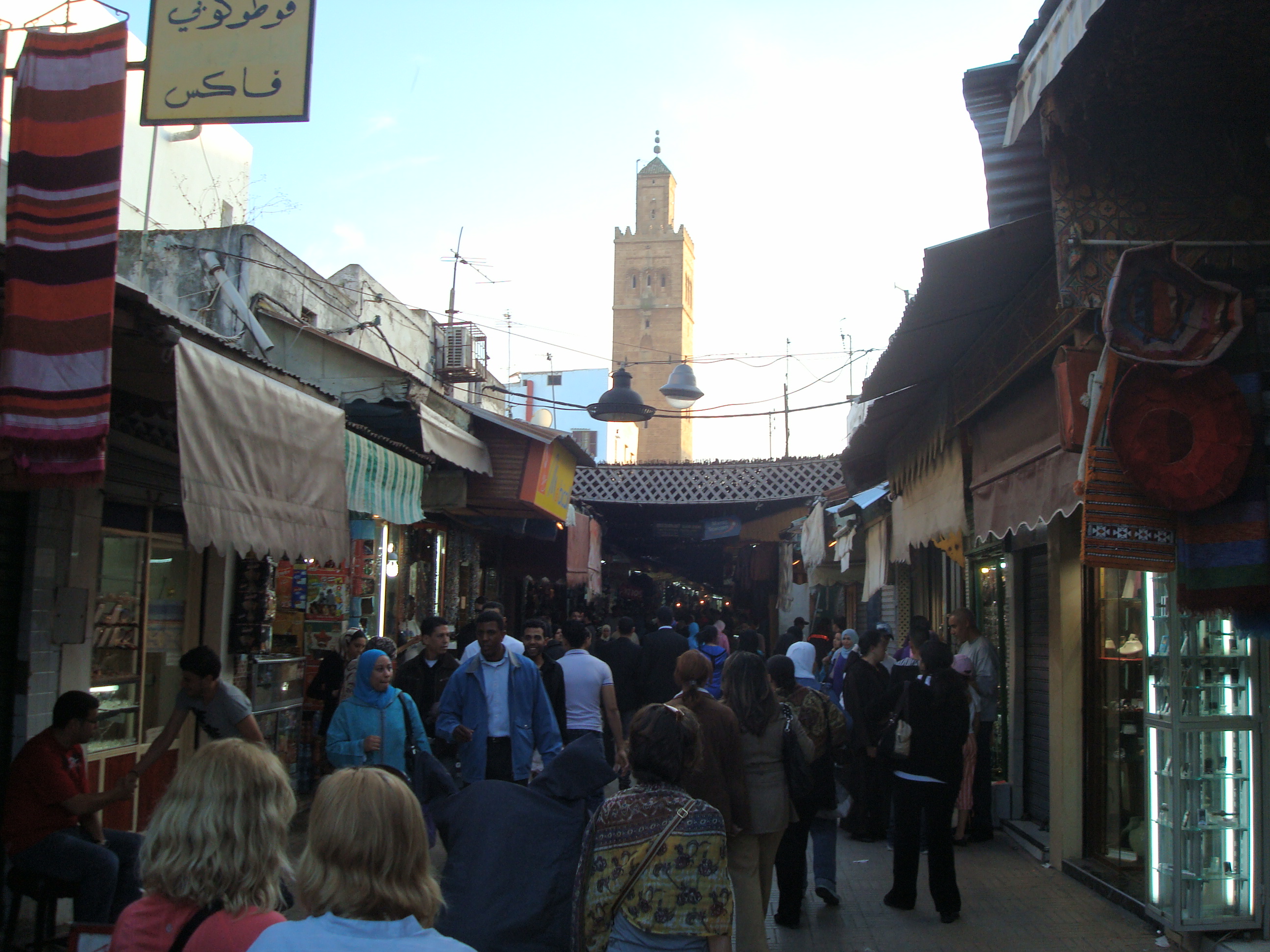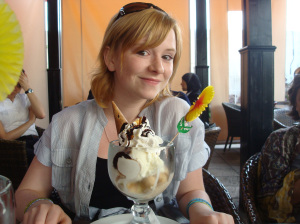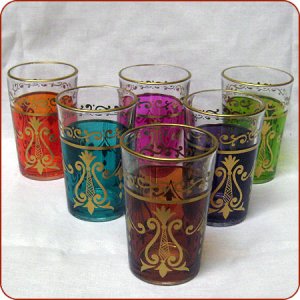We woke the following day later than we had anticipated. Jet lag had finally caught up with us and we slept in until lunchtime as did our roommate, Liz. Unfortunately we missed out on seeing the all-women’s 5K run in the city center. Many people from the house went to either run in it or cheer others on. Even Khadija, the house manager ran in the race dressed in her djellaba (as did many other Moroccan women). I was seriously disappointed that I missed it.
After a big lunch and hearing all of the fun stories about the race, my daughter and I, along with the four others in our week-long, Insight Abroad program – Chris, Liz, Kristina, and Nicole, participated in an orientation meeting with Mohamed, the Country Director, and Abdellah, the Program Coordinator. Each of us had already received our volunteer assignments prior to leaving the States so Mohamed and Abdellah provided us with some basic information about what each of our sites would require of us.
We were next directed us to the other people we would be volunteering with at our sites. My daughter and I were assigned to helping out at Morocco’s only children’s hospital. Our main job was to staff the playroom where the kids on the respiratory ward would come to have the chance to play. Most of the kids in the respiratory ward were there for asthma-related issues and needed to stay in the hospital for weeks at a time. Those kids and their mothers (there were a few fathers there, but not many) were often cooped up in their hospital rooms for days at a time while the doctors adjusted and checked on the kids’ medications. Our job was to help maintain a safe, fun place for these kids to have a play and to give the mothers a brief break for three hours a day during the week.
There was one other volunteer from the house that would be going to the hospital with us each day. She had been in Rabat volunteering with CCS for several weeks by that time so she knew the ropes and was willing to help us ease into the job. I was relieved we wouldn’t be winging it on our own, especially since neither of us spoke French or Arabic.
We had the rest of the afternoon free to do whatever we wanted so the six of us Insight Abroad-ers decided to go to the centuries-old Rabat medina to take in the sites and do a little shopping.
It was late afternoon by the time our cab dropped us off at one of the entrances to the medina. We walked through the archway carved into the wall of the medina and were immediately swept into the crowd that filled the narrow streets from shop to shop. We were only able to move at a slow, shuffling pace because we were tightly squished between each other and the throngs of people. It was so full of people that you couldn’t really stop and look in the shops because you were trapped in the flow of the river of people.
After struggling with the crowd for about an hour, we decided to return another day either earlier or later to be able to enjoy it. During dinner, Khadija told us that late afternoon is the worst time to go to the medina because that’s like rush hour when everyone is there doing their daily shopping after work and before dinner. She advised going in the early afternoon when it was most quiet and easy to get into the shops.
At dinnertime on Sunday we were introduced to more volunteers who had just returned to the house from weekend jaunts in the country. For those who were doing longer volunteer programs, the weekends presented an opportunity to travel around Morocco. Several people had spent the weekend in Marrakech and others were at the coastal town of Essaouira. I loved hearing the stories of these fellow intrepid travelers.
Chris, Liz, Kristina, and Nicole began talking about going to Fez at the end of our volunteer week after hearing our stories about it. My daughter and I had plans to go to Marrakech as soon as our week with CCS was done, though it was becoming very tempting to go back to enchanting Fez. My daughter was lobbying hard for Fez over Marrakech. In short order, laptops were whipped out and smart phones were consulted about the possibility of all of us going together. I was suddenly faced with the decision to go on to Marrakech to see all the wonders there or go back to Fez, a place with which I had fallen in love and wanted to see more.
I remember thinking that if this was going to be my toughest decision during the week, it was going to be a pretty good week.
Earlier that day we had all been taught a phrase that you hear often in Morocco: Insh’Allah. It means “If it is God’s will” or rather if what you are about to do will be within God’s will and is best for Humanity, the Earth, and all of Allah’s creation, then it will be. Sometimes it is said with a shrug of the shoulders as a way to mean if it’s meant to be, it’s meant to be. So, I told my daughter that we would go back to Fez “Insh’Allah” and decided to leave it at that for the time being. Suffice it to say she was nonplussed with this answer.
Following dinner, it was our group’s turn to help clear and clean the dishes. In previous years, the volunteers implemented a system to help with the cooking and cleaning on a daily basis given how much work it is for the women running the house. So, on your arrival day the other volunteers who have been there for a while will assign you to a team and after each meal, if it’s your team’s day, you help clear all the serving plates and bowls into the kitchen and then wash and dry all of the dishes. It was easy to do and frankly, I couldn’t imagine expecting these women to do all of that without lending a hand. It also provided another way to get to know the women who work in the house.
On our last night before a week of volunteering, our little group decided to go out for ice cream and relax a little after the stressful time in the medina. We all had to be up and ready for breakfast by 7:30am because the CCS van would be dropping everyone off at their sites between 8:30am and 9:00am. Busy days were ahead, but we were looking forward to it. And with our afternoons free for the taking, I was also looking forward to the cultural activities that CCS had lined up for us as well as a return trip to the medina to give it a second chance.
The next morning came quickly. After a quick breakfast of pastries, coffee, tea yogurt and fruit, we were ready to go by the time the van pulled up in front of the house. My daughter and I were both nervous and excited to see the hospital and all of the kids there. A million questions zoomed through my head on the ride there: In what ways would the hospital be different from or similar to American hospitals? What do Moroccan children like to play and do for fun? Would the children like me? How would I communicate with them if they didn’t speak English? Would the mothers mind leaving their children with someone who couldn’t speak the language?
The CCS van dropped us off in the parking lot of the relatively modern-looking hospital. Security guards stood sentry at the gate and nodded us through when he recognized Abdellah who was accompanying us that day since we were new to the site. Armed with baskets of coloring sheets, crayons, colored pencils and other art supplies, my daughter and I and the other volunteer entered the three-story building.
The first thing I remember noticing was how dimly lit and crowded the hospital seemed compared to American hospitals I’ve been in. The front lobby had scores of patients sitting in plastic chairs waiting to be seen, many with that look of “I’ve been here for hours and I’m still waiting” that you often see in American waiting rooms. For the most part, though, the layout and composition of the rooms was quite similar to what you would find here in the States.
We were led down one long corridor after another, passing through more security-guarded entryways until we reached the enclosed play space in what used to be an open air courtyard. The hospital, recognizing that they needed a play space for the children staying there, covered the opening above with a clear plexiglass type covering. The result was a brightly lit, yet stifling hot space filled with toys and small climbing structures. The temperatures were supposed to get up to 85 degrees later that day, but at 9am, it was almost 90 degrees in that room and the air conditioning didn’t seem to be doing much to cool it off.
Another thing I noticed right away was the sharp-cornered grating on the floor against one wall that left a big, gaping hole that anyone, especially small children, could easily fall into. I’ve worked in a day treatment facility for the past fifteen years and safety is always our number one priority. Our classrooms are designed with that in mind, down to where the blunt ended kid scissors and pencils are stored (because to an out of control kid, everything becomes an object to hurt someone with). My safety radar was going nuts over this so I rearranged the room a little to block that area and kept an ever vigilant eye on anyone headed that way.
These things ended up not mattering much over the course of the morning, though, because when we unlocked the room, dozens of little kids came pouring out of their hospital rooms excitedly dragging their tired mothers to the play space. With a mixture of hand gestures, some seriously awful French on my part and a few knowing nods, many of the mothers were glad to leave their children with us for a little while. I was relieved it went as smoothly as it did.
And what cuties the children were! Most of them were between the ages of three and six. With bright, smiling faces they jumped and played and took our hands to lead us over to whatever they wanted us to play with them. We played children’s songs (in Arabic and French) on the CD player that was there in the room and many of the kids sang along, encouraging us to do the same.
Of course, it wasn’t all happy songs and cheerful smiles. We quickly learned the Arabic word for no (“La”) and found ourselves using it with increasing frequency with certain mischievous kids. Those were the ones we ended up bonding with the most by the end of the week, no doubt a clever trick on their part to get our attention more often.
When our three hours were up that day, I was overcome with a sense of relief that it had gone as well as it did given that there were only three of us and, at times, up to twenty kids in the small space. Tired, sweaty, and hungry, we said good-bye to our new little buddies, promising to see them the next day, and headed out to the front of the hospital to wait for the CCS van to pick us up.
I don’t have any photos from the hospital because I chose to not bring my camera to our volunteer site. I felt like it would be disrespectful for me – a healthy, privileged American – to be snapping photos of people who are there feeling vulnerable and sick. I wouldn’t want someone doing that to me if I was in the hospital. Plus, I was there to experience things and to help, not create photo ops. There have been other volunteers who have taken photos at their sites, including at the hospital, and I’m not judging them for that. I would have loved to snapped a few photos of some of those adorable kids. But in the end, it just didn’t seem right for me and I felt I would have been taking more than I was giving.
Lunchtime back at the house was a flurry of tales to be heard about what happened at all of the volunteer sites. In our cohort, Nicole, Liz, and Kristina were all assigned to the children’s orphanage. They looked exhausted as they talked about the large number of infants and toddlers that needed their attention and care. They had spent their morning getting the children up from their cribs, bathing them, feeding them and playing with them. They talked about how there just simply wasn’t enough people there to give all of the children the attention they needed and sometimes a few kids were left crying in their cribs for a while until someone could attend to them. Khadija jumped in the conversation to say that many of those children are placed at the orphanage when a girl or woman has become pregnant outside of marriage. Because of the extreme shame brought on the family because of this, many girls and women are forced to place their babies there instead of raising them on their own. Heartbreaking stuff. This was definitely the most challenging placement for volunteers.
Chris, on the other hand, was working with a group of teenage boys and young men teaching them English. He said they were a very engaging group, eager to learn and to hear stories about America. He was really enjoying his placement.
That afternoon, many of the volunteers set about doing their own thing. Mohamed and Khadija offered to hold a Q & A about women and Islam for our cohort. We learned about the five tenets of Islam and how that translates into everyday life. We learned about the expectations for women, especially around the way they dress and who they’re seen with in public. We also talked about how similar the Islamic faith is to Christianity, vs. all the differences that seem to be focused on in American media. It was completely fascinating. Even the teenager was engaged and listening.
When the discussion wrapped up it was nearly time for one of my favorite parts of the day there: afternoon tea time. Trays of pastries and fruits were laid out in the common room along with piping hot carafes of sweet, sweet mint tea. Moroccans like their tea VERY sweet and honestly, it is quite good that way. Pungent and minty, it’s served in little glass tumblers in small quantities. I loved it.
That night we all decided to relax at the house. Many people were lounging around, writing in journals, typing on laptops, Skyping with family and friends, and preparing for their next day of volunteering. For us that meant making sure the toys and art supplies that we were bringing were ready to go. For others, that meant making lesson plans and planning outings with their students.
It was an tiring, yet eye-opening day. As I drifted off to sleep, I was thinking about seeing our little buddies at the hospital the next day as well as looking forward to whatever adventures lay ahead for the afternoon.
In my next post, I’ll share about the cultural activities we participated in through CCS as well as our return trip to the medina, an afternoon spent at the beach, and a visit to two different kasbahs.
Until then, dear readers, I’d love to hear about your thoughts and questions on our volunteer placement, life in the home base, the cultural differences I noticed, or anything else you might be wondering about. Ask away!








on ,
livrancourt said:
Was there another group of volunteers to work in the play area during the afternoons? It sounds like such an amazing experience!
Thanks for sharing the story.
on ,
Tami Clayton said:
No, the play area was only open during the mornings when we were there. I believe the CCS volunteers were the only ones who staffed it. That may have changed since we were there.
on ,
Catherine Johnson said:
What an amazing experience. I can’t believe children are being taken away for religious reasons, that is so sad when there are enough orphans in the world already. Wouldn’t it be more humane for the women to have to stay with them or something?
on ,
mrbradjones said:
Hi, thanks for writing. It is great to hear about your experience in this hospital. I’m an American living in Tangier, and i’ve had a lot of the same feelings and frustrations as you. It’s quite a journey being an American in Morocco. Thanks again for sharing.
on ,
Tami Clayton said:
Thanks for stopping by and commenting! What took you to Tangier? You must have some fascinating stories.
on ,
mrbradjones said:
Yeah, I finished graduate school and my family and I decided to explore the possibility of starting a business in Morocco, rather than start a career in America. We have some friends over here, and so we just went for it 🙂
on ,
Tami Clayton said:
Very cool! Is the business the hotel in your email address?
on ,
mrbradjones said:
Yes, but it hasn’t been built yet… Insha allah 🙂
on ,
Tami Clayton said:
Yes, Insh’allah. 🙂 Best of luck to you and your family on your adventures!
on ,
Mike Schulenberg said:
Sounds like quite an experience, and size of that ice cream is intimidating. I feel sorry for the kids who get taken away from their moms 🙁
on ,
Tami Clayton said:
Yes, it is a sad thing for the children. It was quite the emotional experience for the volunteers working at the orphanage, which I think is why we were placed at the hospital since I was doing the program with a 13 y.o.
on ,
Mike Schulenberg said:
Yeah, that sounds like it would be pretty rough.
on ,
Julie Farrar said:
For not having traveled much, you definitely jumped in with both feet. When traveling in European countries I noticed differences in so many things, but I can imagine that going to a non-European country it might have felt at times like being on another planet. Can’t wait to read more.
on ,
Tami Clayton said:
Yes, Julie, I jumped in with both feet but I knew I had a supportive safety net going through CCS. That made all the difference, especially traveling with my daughter.
on ,
Sherry Isaac said:
Tami, right now, I’m just taking this all in. I’ve been fortunate to do a little travelling, but my exposure to other cultures has been purely as a tourist. I know I have barely scratched the surface.
I am adding a volunteer mission such as yours to my life list, target: 2-3 years. Thanks for putting this experience on my radar.
on ,
Tami Clayton said:
I’m so happy to hear you’re thinking of doing a volunteer trip! Yay! It really does lend a whole other perspective to travel.